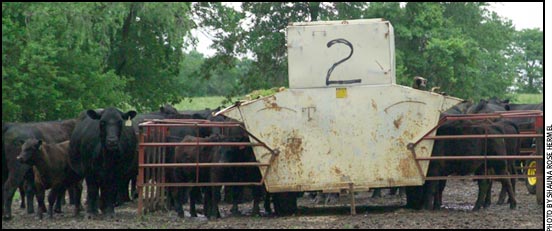
Time To Creep?
Scorching weather may call for creep-feeding of calves.
The oppressive heat wave that has scorched pastures and dried water sources in recent weeks should have farmers in the Northeast thinking about creep-feeding their beef calves, according to an animal scientist in Penn State's College of Agricultural Sciences.
Creep-feeding — which is simply a way to increase weaning weight by supplementing grass and milk for unweaned calves or to supplement milk production in periods of nutritional stress for cows — is a valid option now, said John Comerford, associate professor of dairy and animal science.
"However, the decision to creep-feed or not to creep-feed is a difficult one for producers," said Comerford, who coordinates Penn State's beef programs. "Like most other aspects of the beef business, it's a complex decision and one that has to be analyzed year after year.
"This management decision has lots of variables and responses that are not always predictable."
Each producer has to weigh independently if creep-feeding is financially feasible for them, noted Comerford. The logical questions to ask before creep-feeding calves, he said, are "How much will it cost?" and "How much does it pay?"
"Creep-feeding, of course, implies there will be purchased feed provided for the calves, usually on a limited basis," he said. "This implication also includes facilities, equipment and labor to provide the feed."
Comerford offered this sample calculation:
Costs:
40-calf creep feeder costing $1,000 with a 10-year life: $2.50 per calf
Feed at $0.20 per lb. x 3.5 lb. per day x 100 days: $70.00
Interest on feed at 4%: $0.16
Total estimated cost: $72.66 per calf
The payoff:
Additional weaning weight of 0.6 lb. per day (total 60 lb. at $1.45 per lb.): $87.00
Net return to labor and management: $14.34
But creep feeding does not always pay off, Comerford cautioned.
"It appears on the surface that creep-feeding would be a profitable management tool at any time, but there are other considerations," he said. "The total weight gain should not be used as the predictor of additional value of calves. Additional weight on calves usually also implies a lower value per pound when they are sold, so the total value of the calf should be considered."
Comerford cited the following example: An examination of feeder-calf values in the Northeast from fall 2005 shows an average value of $1.12 per lb. for 500-lb. calves (total value of $560) and a value of $1.22 for calves weighing 440 lb. (total value of $536.80).
"The difference in total calf value must be sufficient from feeding to add the additional 60 pounds of weight," he explained.
"For calves in which ownership is retained through the feeding period, there usually will be no advantage in weight. The non-creep calves eventually will catch up."
Other factors involved in creep-feeding calculations include feed efficiency, feed palatability and cost, carcass grade, marbling accretion, preconditioning programs, and weaning.
"Costs and returns should determine the decision to provide creep-feed," Comerford said. "Consider all the variations in calf value and management plans in making the decision. But if the current searing heat continues, perhaps turning into a drought — and causing stress to cows — creep-feeding is an option to be considered."
[Click here to go to the top of the page.]














